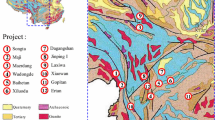Conclusions
-
1.
Construction of dams by the flow-line technology provides a high rate of their construction with minimum labor expenditures.
-
2.
Construction of rock embankments from a rock mass by the method of compaction due to the kinetic energy of impact provides sufficiently reliable compaction of the fill.
-
3.
By such a method it is possible to construct embankments from strong rocks. Weak rocks at the time of impact will be broken, not providing reliable compaction of the fill.
Similar content being viewed by others
Literature cited
N. Ya. Kharkhuta and Yu. M. Vasil'ev, Stability and Compaction of Soils of Road Embankments [in Russian], Avtotransizdat, Moscow (1964).
G. G. Lapin and A. D. Shargorodskii, “Experience in constructing high earth dams abroad,” Gidrotekh. Stroit., No. 5 (1991).
Yu. A. Yakhontov and V. A. Krasnov, “Transport of sand-gravel and concrete mixes by belt conveyors in power construction. Review information,” Informénergo, Ser. Teplovye Élektrostantsii, Teplofikatsiya i Teplovye Seti, No. 6 (1988).
Additional information
Translated from Gidrotekhnicheskoe Stroitel'stvo, No. 6, pp. 25–26, June, 1992.
Rights and permissions
About this article
Cite this article
Krasnov, V.A., Moiseev, A.I. Compaction of rock fill during flow-line construction of dams. Hydrotechnical Construction 26, 345–347 (1992). https://doi.org/10.1007/BF01545615
Issue Date:
DOI: https://doi.org/10.1007/BF01545615




